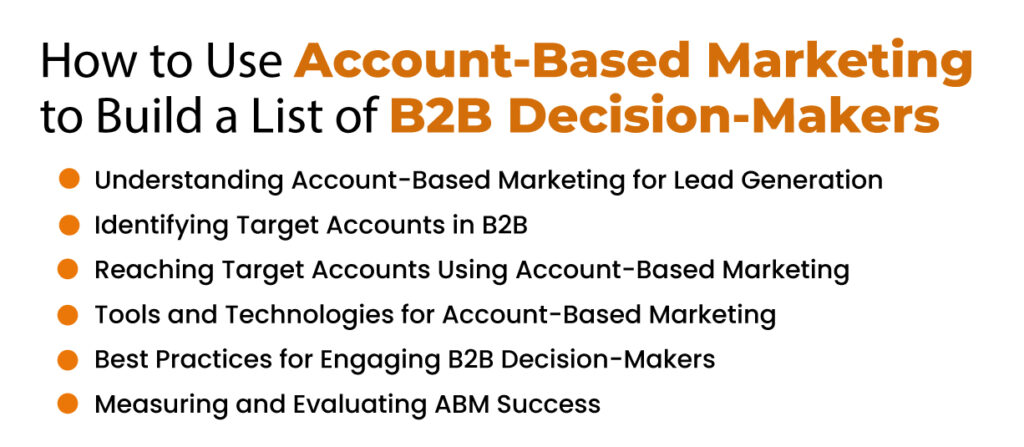
Introduction
Table of Contents
In the realm of B2B marketing, precision is paramount. Account-Based Marketing (ABM) has emerged as a powerhouse strategy for crafting tailored engagements with key decision-makers. Unlike traditional methods, ABM allows businesses to focus on personalized outreach, ensuring a higher chance of success by engaging with specific, high-value target accounts.

Understanding Account-Based Marketing for Lead Generation
ABM is a strategic approach that involves aligning marketing efforts with sales goals, targeting select accounts rather than broad demographics. Research from Alterra Group found that 97% of marketers achieved a higher ROI with ABM than with other marketing initiatives. This approach emphasizes personalized interactions, ensuring a deeper connection with decision-makers within target accounts.
Identifying Target Accounts in B2B
The foundation of successful ABM lies in identifying the right accounts. Collaborating closely with sales teams, marketing professionals can define Ideal Customer Profiles (ICPs) and buyer personas. According to a study by TOPO, 80% of marketers surveyed said that ABM significantly outperformed other marketing initiatives when it comes to ROI.
Must Read: How to use your B2B list to generate leads and sales
Reaching Target Accounts Using Account-Based Marketing
Once target accounts are identified, tailored campaigns become crucial. These campaigns may involve crafting personalized content, utilizing multiple communication channels, and orchestrating experiences to resonate with the needs of decision-makers. Research by ITSMA discovered that 85% of marketers who measured ROI described ABM as delivering higher returns than any other marketing approach.
Tools and Technologies for Account-Based Marketing
ABM is bolstered by a range of tools and technologies. These include Customer Relationship Management (CRM) systems, marketing automation platforms, data analytics tools, and account-based advertising platforms. The implementation of such tools has led to a reported 91% increase in average deal size for companies using ABM, according to a study by Sirius Decisions.
Must Read: Automating B2B List Building: Tools and Techniques for Streamlined Lead Generation
Best Practices for Engaging B2B Decision-Makers
Effective engagement with B2B decision-makers via ABM involves several best practices:
- Crafting personalized and compelling content aligned with each account’s needs.
- Utilizing multiple touchpoints across various channels for enhanced outreach.
- Nurturing relationships through personalized interactions and value-driven communication.
- Facilitating seamless collaboration between sales and marketing teams.
Read this insightful article about How to Get Appointments with Descision-Makers?
Measuring and Evaluating ABM Success
Measuring the success of ABM efforts is crucial for refinement and optimization. Metrics like engagement rates, conversion rates, pipeline velocity, and customer lifetime value offer insights into the effectiveness of ABM campaigns. A study by Marketing Professionals and the Content Marketing Institute revealed that 87% of B2B marketers agreed that ABM generates a higher ROI than other marketing activities.
Must Read: Different types of ABM
Conclusion
Account-Based Marketing revolutionizes B2B lead generation by focusing efforts on personalized engagements with high-value accounts and decision-makers. By leveraging personalized strategies, targeted outreach, and cutting-edge technologies, businesses can not only build a quality B2B decision-maker list but also foster enduring relationships that drive conversions and long-term business growth.
In conclusion, ABM has proven to be a transformative force in B2B marketing, emphasizing tailored engagements that resonate with decision-makers, leading to increased conversion rates, higher ROI, and strengthened partnerships.

Vikas Bhatt is the Co-Founder of ONLY B2B, a premium B2B lead generation company that specializes in helping businesses achieve their growth objectives through targeted marketing & sales campaigns. With 10+ years of experience in the industry, Vikas has a deep understanding of the challenges faced by businesses today and has developed a unique approach to lead generation that has helped clients across a range of industries around the globe. As a thought leader in the B2B marketing community, ONLY B2B specializes in demand generation, content syndication, database services and more.


